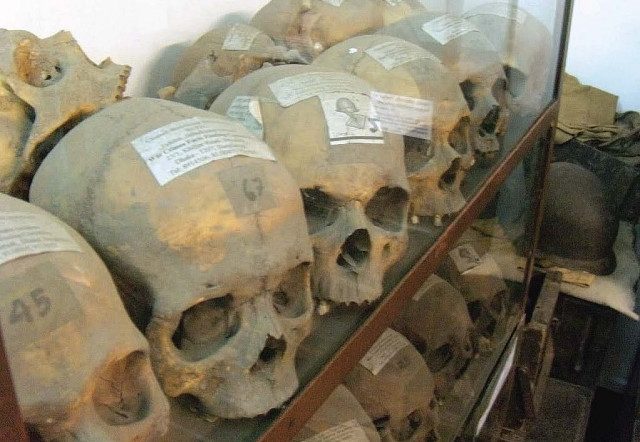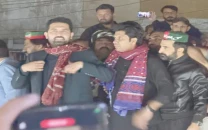Death in Dhaka
Few things will make one sick to the stomach as quickly as some of the mementoes of the 1971 war in Dhaka.

As a Pakistani schooled in a sanitised version of history, the museum makes one cringe with revulsion. Skulls and bones recovered from a killing field in Mirpur, Dhaka, stare at you from a glass cupboard. A black and white image shows vultures picking at the bodies of those left for dead. In another image, a snake is stretched out on the back of a dead body — an unknown victim of the cyclone that battered East Pakistan in 1970, and led to increased feelings of alienation amongst East Pakistanis with the slow aid response from West Pakistan. Lewd sketches of women are among the graffiti found in a Pakistan Army camp.
My tour guide turns to me, “You tell me, how can we forgive or forget this?” Umm-e-Hani Shoily is a college student and, though this is her third visit to the museum, some of the images still fill her with horror.
Occupying a two-storeyed house, the Liberation War Museum documents the history of East Pakistan from the days of British Rule to 1971. Established in 1996 by the Liberation War Museum trust, a group of individuals focused on preserving and presenting history, the museum is funded by the Government of Bangladesh and donations from an NGO and individuals. Images of slain army officers, women and intellectuals dot the walls and a separate room is dedicated to notable personalities that led the war. Amena Khatun, an archivist and curator at the museum, says the place sees up to 150 visitors every day. The collection of pictures and mementos has been primarily given by private donors. “This is amazing, people feel the urge to preserve their belongings and their history,” says Khatun.
Khatun is amongst the millions of Bangladeshis who lost a loved one in 1971 — her father, a furniture shop owner and supporter of the Mukti Bahini, went missing in May 1971. His body was never found.
In 1999 hundreds of skulls and bones were discovered in a mass grave in Dhaka. “A Bihari man, who had been involved in the massacre told us about this mass grave, which was then excavated with the help of the authorities. There are many killing fields around here.”
Though the man who pointed out the location of the killing field is still free, Khatun is optimistic: “We can’t trace everyone, but the war crimes tribunal is working on identifying and trying the main culprits involved in these incidents.”
Arriving in Bangladesh as the Cricket World Cup 2011 kicked off in Dhaka, all one could see in the capital were green and red flags; the patriotism in the air was palpable. But with the patriotism, there is a constant reminder everywhere in Dhaka of what 1971 stood for. On walls, there are sketches of the 1971 war — including an image of a Pakistan Army soldier snatching a Bengali girl’s dupatta. “We don’t hate Pakistanis,” says Shouli. “But everyone here has lost someone in the war: fathers, brothers, sisters, mothers.”
Khatun sums up the patriotism of Bengalis, “We went through 200 years of British rule, and then the Pakistan rule, after which we got our own nation.”
Even those who didn’t lose a direct relation in the war suffered, like Swatee Majid, the owner of the house where the museum is currently based. “Our entire family was scattered, some of them had to leave,” she says. “When we were part of Pakistan, they never accepted us, or our language. What has changed since 1971 though is that we’ve become more rough in terms of our natures as a result of what happened.”
Khatun feels that a way forward would be for the Government of Pakistan to apologise and acknowledge the events leading up to and of 1971. “Its not possible to forget, especially for those who lost everything. Pakistan must apologise.”
According to Mofid ul Haque, one of the trustees of the museum, “The idea is to move beyond the conflict. We have to learn lessons from the events and look at the reasons as to why this happened.”
But with Pakistan unwilling to accept responsibility, the possibility of that seems remote. The Hamood ur Rehman Commission report, which was supposed to investigate the events of the 1971 War, states: “According to the Bangladesh authorities, the Pakistan Army was responsible for killing three million Bengalis and raping 200,000 East Pakistani women. It does not need any elaborate argument to see that these figures are obviously highly exaggerated.”
Despite testimony given by military officers to the effect that massacres of innocent people did take place — for example: “Lt Col SM Naeem (Witness No 258) CO of 39 Baluch said “innocent people were killed by us during sweep operations and it created estrangement amongst the public” — textbooks, political and military leaders continue to whitewash the documented massacre and rape of Bengali men and women.
“What amazes me, after one looks at all of this (in the museum), is that there is still war and conflict going on,” says Majid.
Haque concurs, “We must move beyond the conflict — it’s a difficult challenge, but we must start the process. We’ve presented facts and documents at the museum, but we will continue to ask why this happened.”
Published in The Express Tribune, Sunday Magazine, March 20th, 2011.


















COMMENTS
Comments are moderated and generally will be posted if they are on-topic and not abusive.
For more information, please see our Comments FAQ